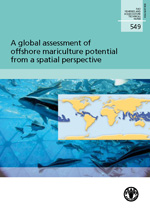|
ABSTRACT
Kapetsky, J.M., Aguilar-Manjarrez, J. & Jenness , J. 2013.
A global assessment of potential for offshore mariculture development from a spatial perspective.
FAO Fisheries and Aquaculture Technical Paper. No. 549. Rome, FAO. 181 pp.
This publication was produced in recognition that there is a growing need to increasingly transfer land-based/coastal aquaculture production systems further offshore as a result of the expected increases in human population, competition for access to land and clean water needed to increase the availability of fish and fishery products much needed for human consumption. Mariculture, in particular offshore, offers significant opportunities for sustainable food production and development of many coastal communities, especially in regions where the availability of land, near shore space and freshwater are limited. This publication provides, for the first time, measures of the status and potential for offshore mariculture development from a spatial perspective that are comprehensive of all maritime nations and comparable among them. It also identifies nations that are not yet practicing mariculture that have a high offshore potential. The underlying purpose of this document is to stimulate interest for detailed assessments of offshore mariculture potential at national levels. Remote sensing for the sustainable development of offshore mariculture is included as Annex 3 to this publication in recognition of the importance of remote sensing as a source of data for spatial analyses to assess potential for offshore mariculture, and also for zoning and site selection as well as for operational remote sensing to aid mariculture management. |

 - 30 Mb Download ZIP version
- 30 Mb Download ZIP version  - 27 Mb
- 27 Mb